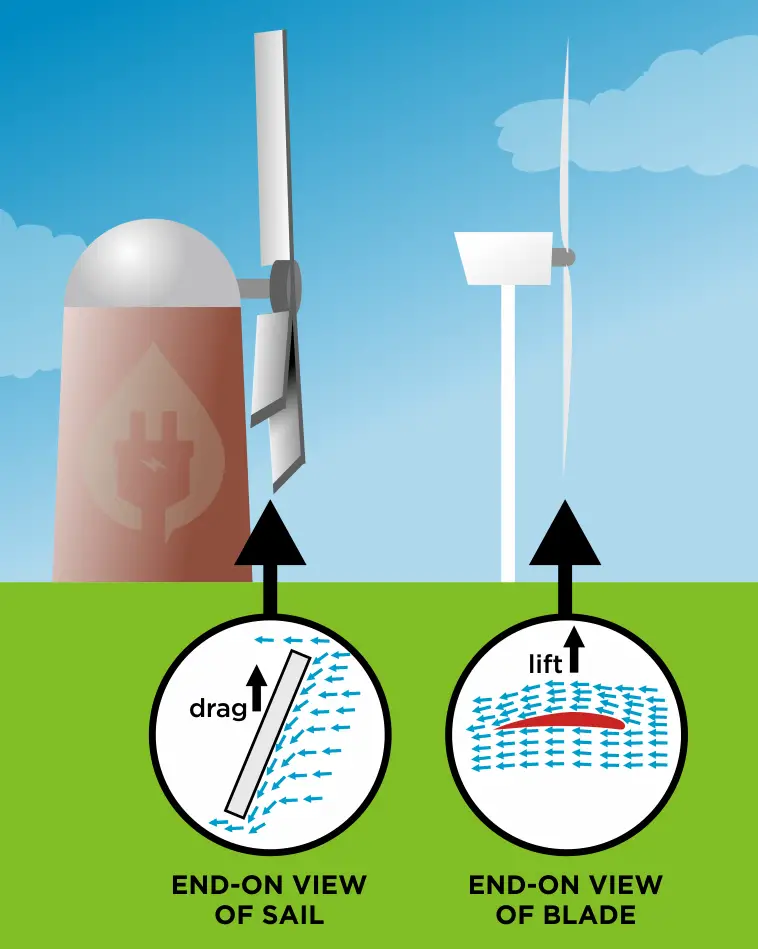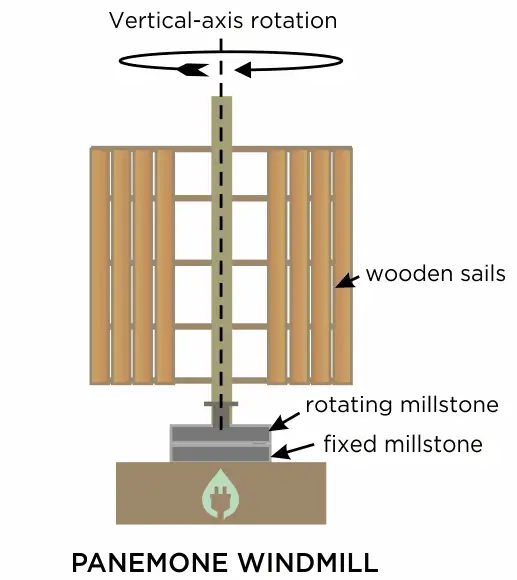With their large rotating arms, windmills and wind turbines can be similar to look at, but they are in fact very different things. The most significant difference between a windmill and a wind turbine is what they do with that rotational energy.
A windmill is a wind-powered structure that grinds cereal grains like wheat or corn (although some windmills were used for other tasks like sawing wood or pressing oil), whereas a wind turbine is a wind-powered structure that generates electricity.
Table of Contents
Wind Powered
Both Windmills and Wind Turbines are powered by the wind. To be able to use the energy from the wind, they use large sails (in the case of windmills) or blades (in the case of wind turbines) that capture the wind, causing them to turn an axis shaft. That rotating axis is then used to either turn a grinding wheel to mill wheat or corn (in a windmill), or to turn a generator to generate electricity (in a wind turbine).
Difference in Capturing the Wind: Drag vs Lift
Windmill sails and wind turbine blades are different in the way they capture the energy in the wind and turn it into rotation of the axis shaft. A windmill sail uses the aerodynamic principle of ‘drag’, and the wind turbine blade uses the aerodynamic principle of ‘lift’.
In both the windmill sail and the wind turbine blade, an upward motion is achieved (see illustration below). But the two methods are quite different in how they achieve that upward motion.

In the case of the windmill sail, the air pushes directly against the sail, and because the sail is angled to the incoming wind, this causes the sail to move up (or down, depending on the angle of the sail), thereby rotating the axis shaft to which it is attached. This upwards / downwards movement is generated by the aerodynamic principle of drag.
In the case of the turbine blade however, the blade itself has a cross-section shape like that of an airplane wing. The upper side of the blade is a longer curve than the lower side of the blade, thereby causing the air pressure above the blade to be higher than the air pressure below the blade as the wind blows past it.
This difference in air pressure causes the aerodynamic effect of lift and causes the blade to move up, and thus rotating the axis shaft. This lift effect is identical to that on an airplane wing that keeps the craft in the air while flying.
Difference in How Long Windmills and Wind Turbines Have Been Around Ror
Humans have been using windmills to grind wheat and corn for over 1000 years. Amazingly, some of the most ancient windmills on earth are still in operation today.1 They are called Panemone windmills, and rather than turning horizontally like a more recent windmill, they turn on a vertical axis, as shown below:

The use of windmills spread across Europe during the 12th Century AD, primarily to grind cereal grains, but by the 14th Century AD, windmills were also being used to pump water, particularly to reclaim land by draining wetlands in the Netherlands.
The use of windmills approached its peak in the mid-19th Century, when there was estimated to have been about 200,000 of them in operation in Europe. Their use has declined since that time, and now there are only about 1,000 operational windmills left in Europe, mostly run by volunteers as educational / museum pieces.2
By comparison, wind turbines are a much more recent invention. They have been around for only just over 130 years. It was in July 1887, in Scotland, UK, that Professor James Blyth became the first person to generate electricity from a wind turbine.
In his back garden, he built a turbine that was driven using 10m diameter cloth sails, looking much like a traditional windmill. No photographs of this machine exist, but in his own words, Professor Blyth described it as a “33-foot windshaft, four arms of 13 feet with canvas sails, and a Burgin dynamo driven from the flywheel using a rope."3
Today (as of 2021) there are over 341,000 wind turbines operating across the world. Given the world’s increasing need for electricity and the imperative to lower our carbon emissions to slow down global warming, this figure will only continue to rise for the foreseeable future.4
Difference in Size Between Windmills and Wind Turbines
Windmills were built in various sizes depending on their function and location – but generally the most common European style windmills were built about the size of a three or four story house, with sails between 20-30 feet long.
Since Professor Blyth’s first wind turbine, many people around the world began to appreciate the value of generating ‘free electricity’ from the wind, and wind turbine development accelerated rapidly. It was quickly realised that the larger the turbine, the more efficient it was, and so the race was on to build bigger and bigger wind turbines.
By the mid-1990s, commercial, grid-scale wind turbines were about 30m (100ft) tall. Today however (2021), the largest wind turbines under construction are truly gargantuan examples of civil engineering. The world’s largest turbine, the MingYang Smart Energy 16.0-242, measures in at a stupendous 242 metres (just over 790ft) tall.5 Each of its three blades are 118m (387ft) long.
Difference in Construction Between Windmills and Wind Turbines
Windmills were built from timber, stone or brickwork – some even doubled up as a house, and many mill owners even lived in the lower floors of their windmills.
Making the blades as light and thin as possible whilst still being rigid and strong enough to withstand the stresses of rotation for years is the prime constraint in manufacturing a modern wind turbine.
For this reason, the latest high-strength, low-weight composite materials like carbon fibre and glass fibre are used. The main tubular support pillars are made from steel, built on large, re-enforced concrete foundations. These material considerations are also as a result of the recycling process, once the turbine meets its end-of-life. Rapid advances in materials technology have helped wind turbines to grow to the enormous sizes we now see.

